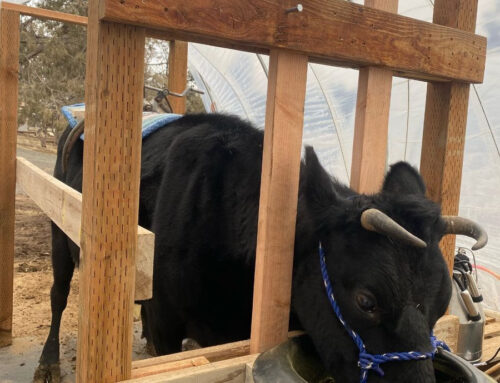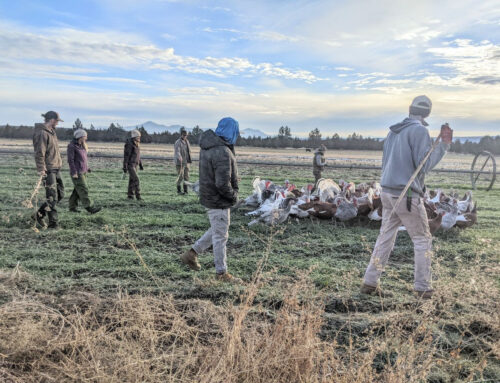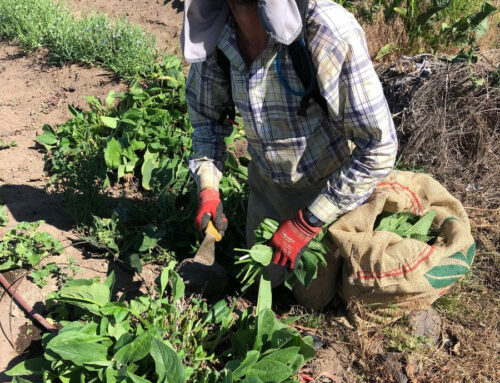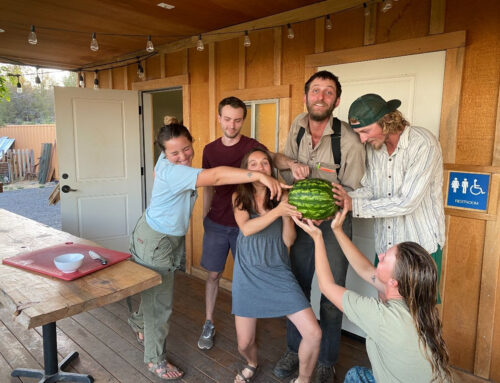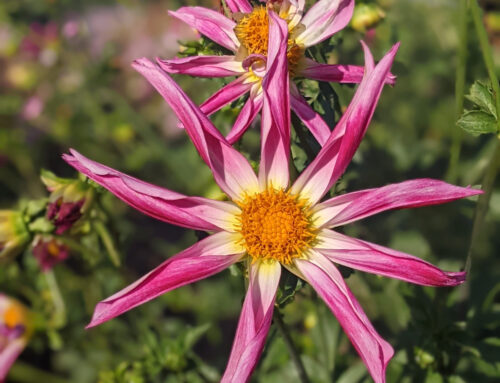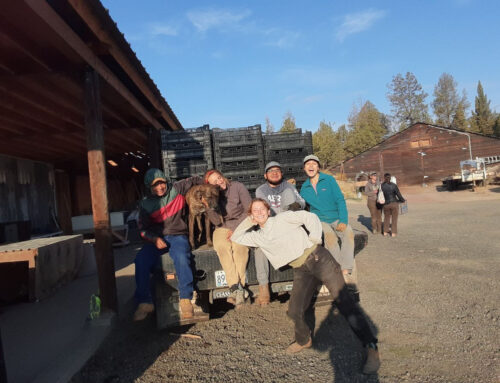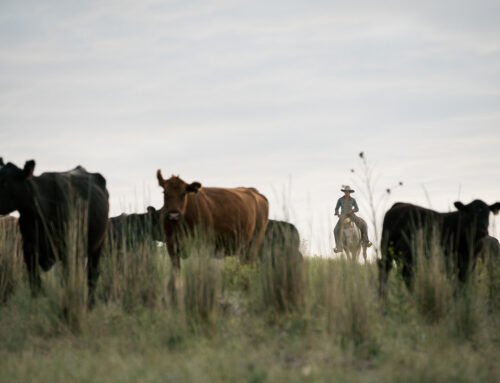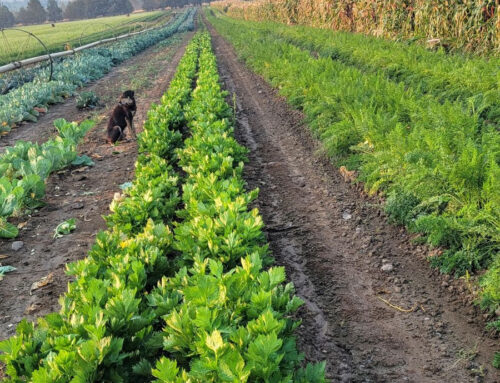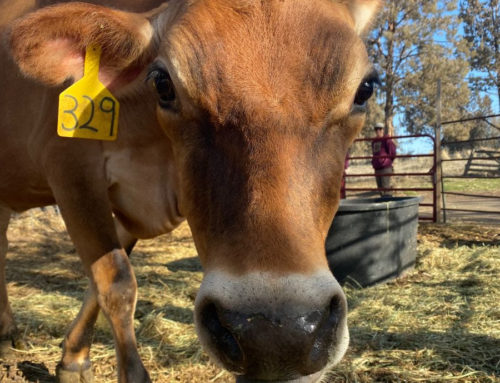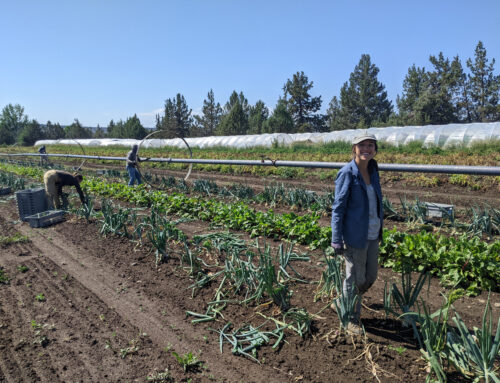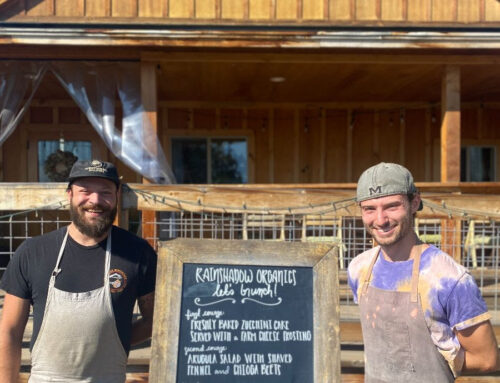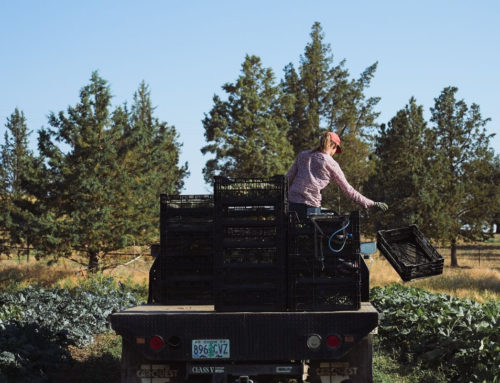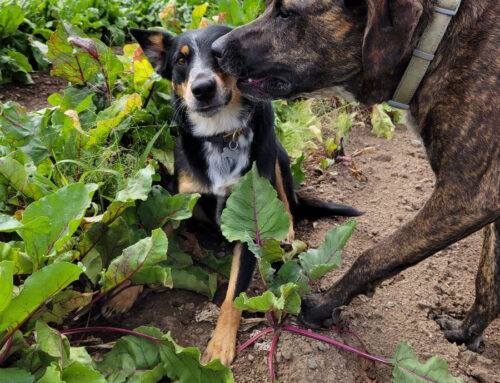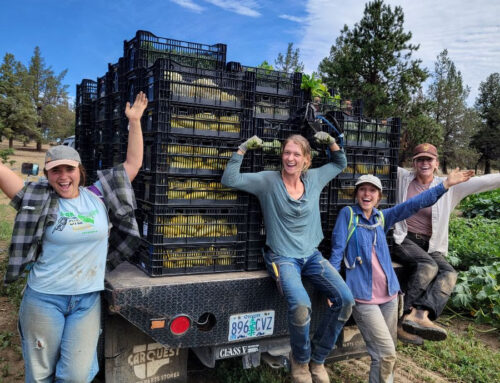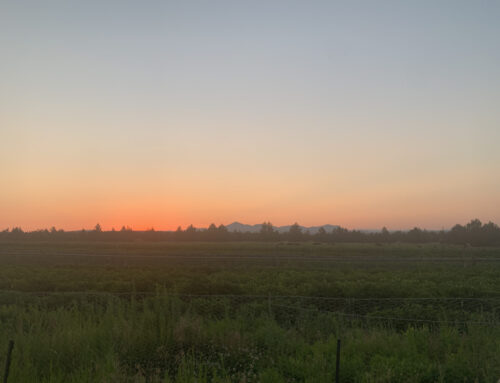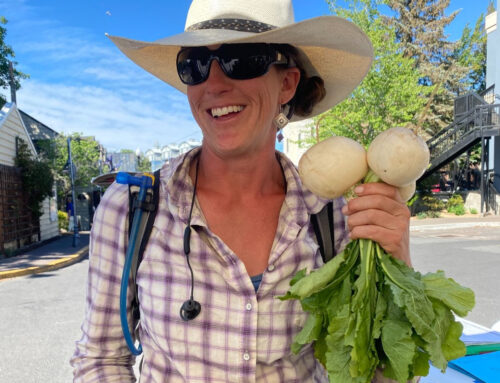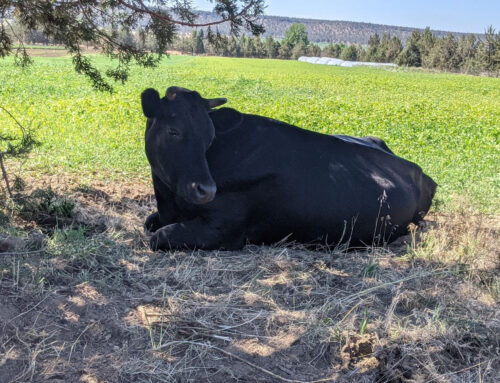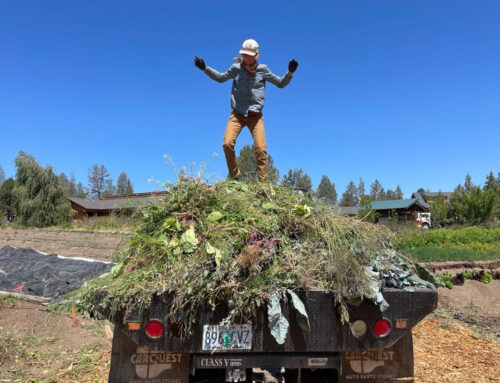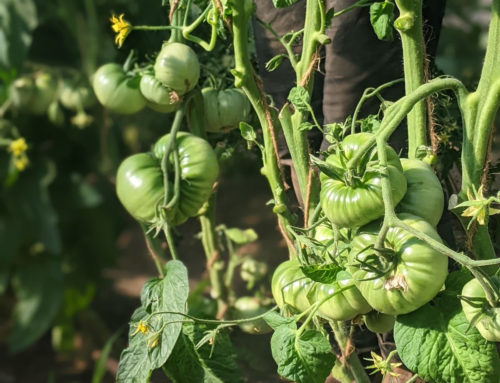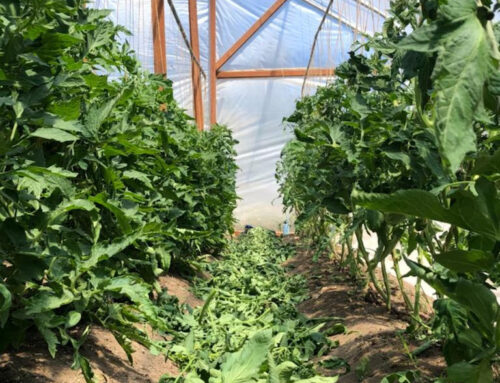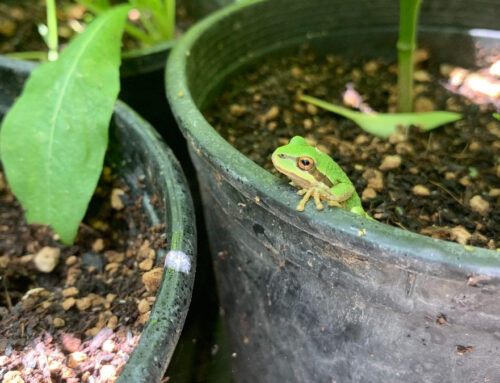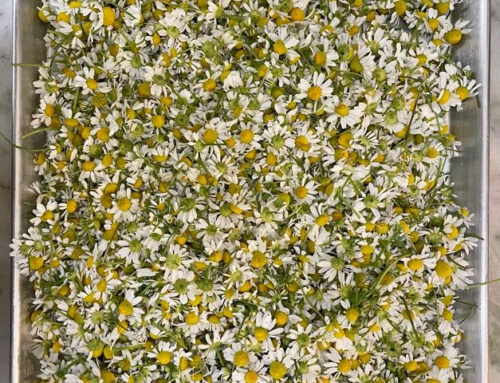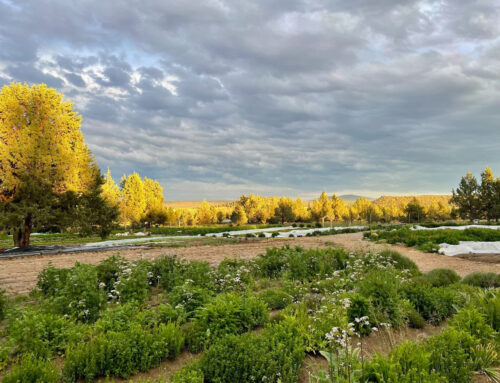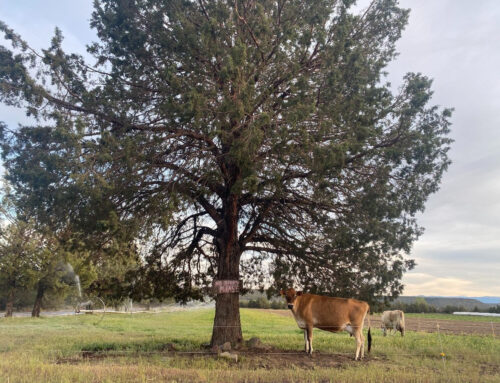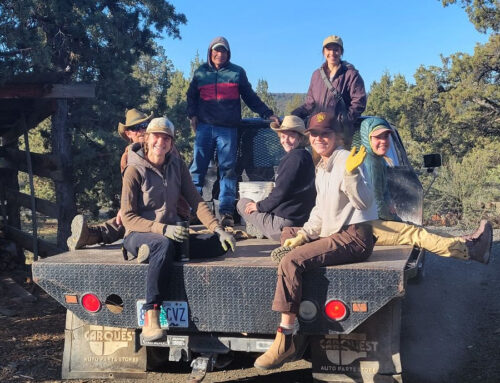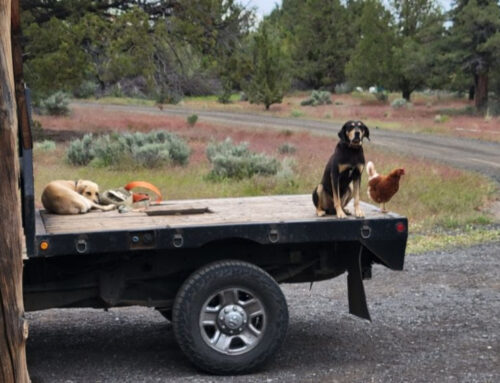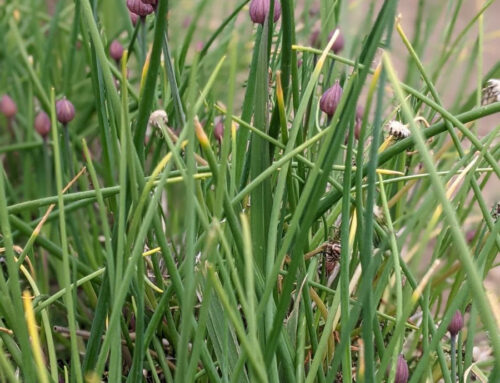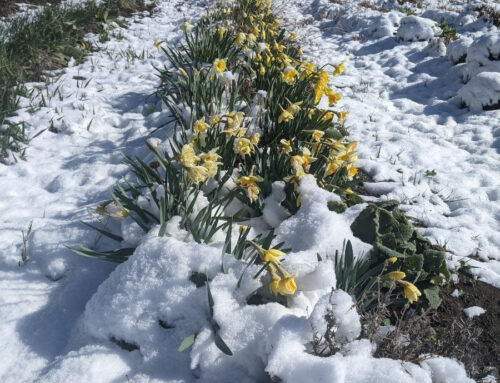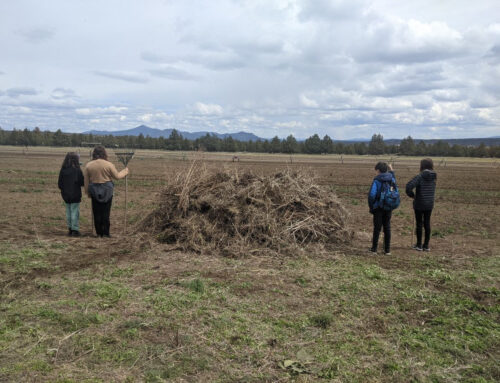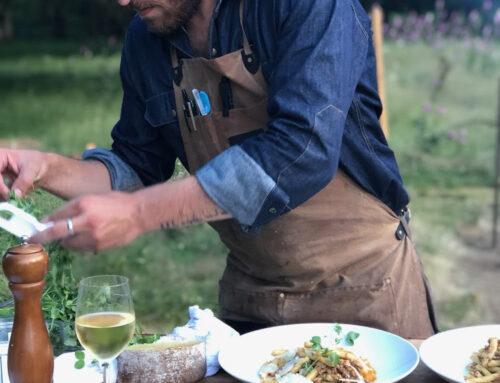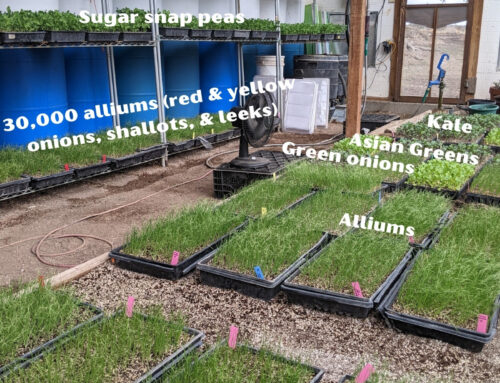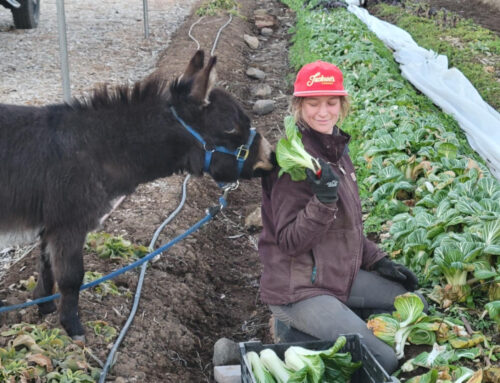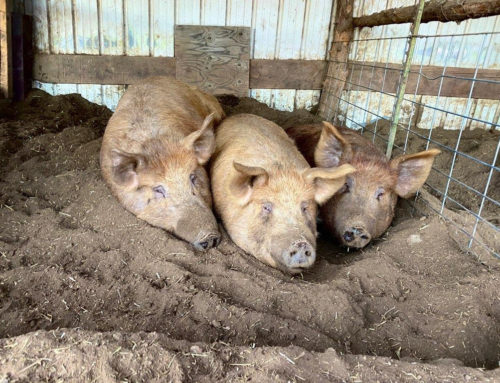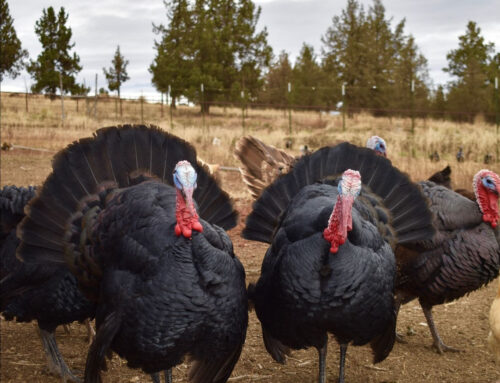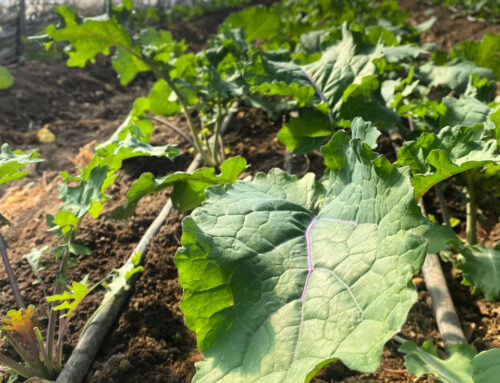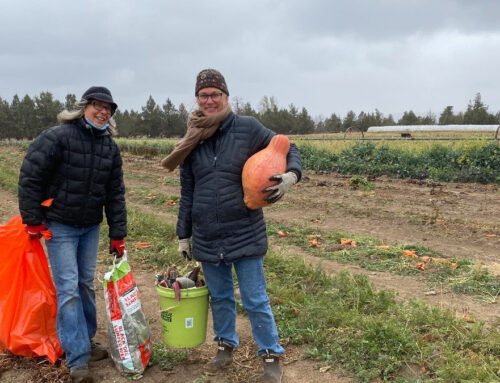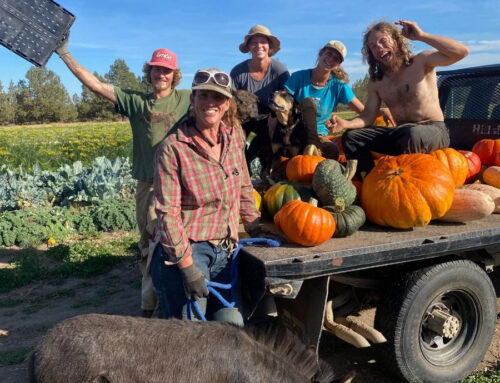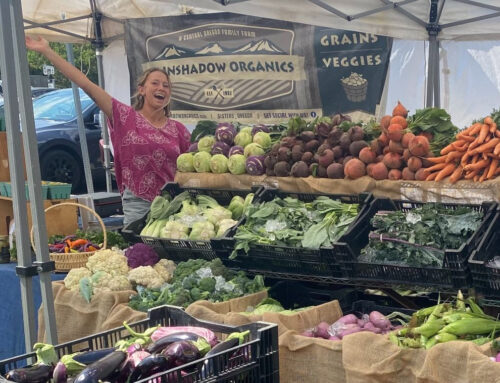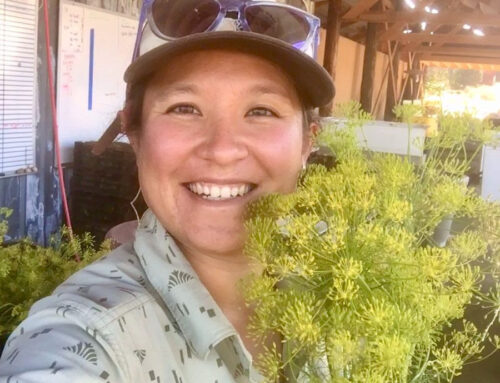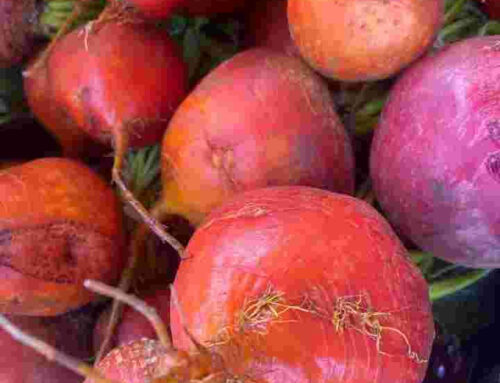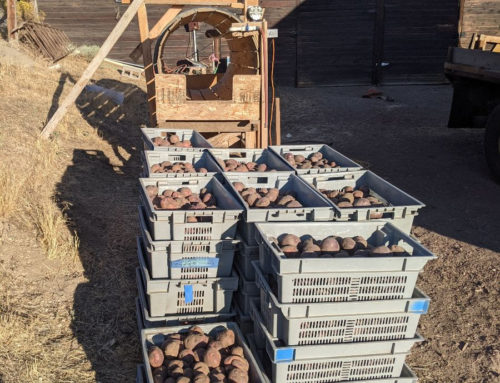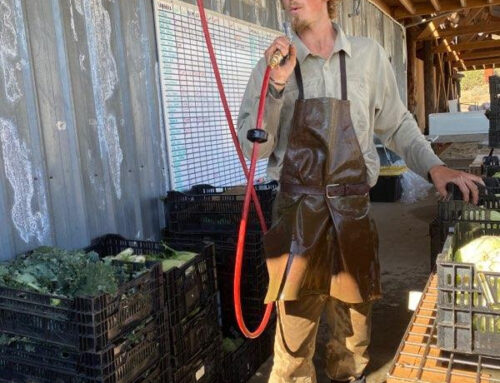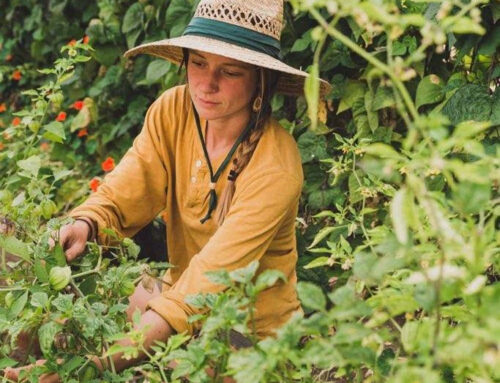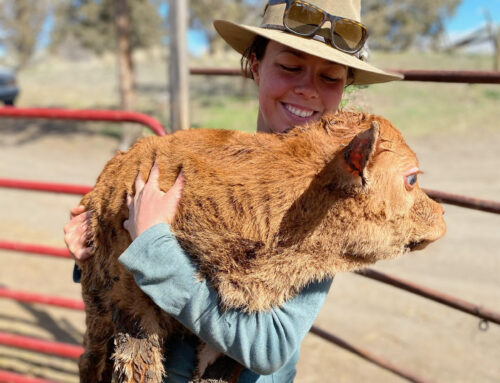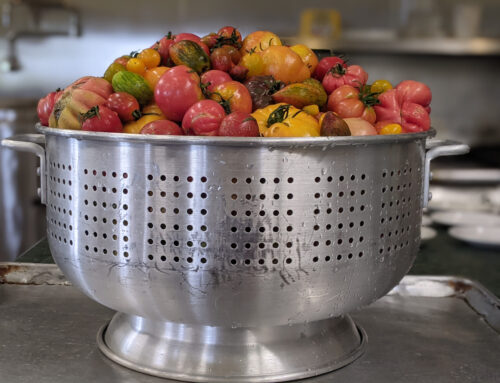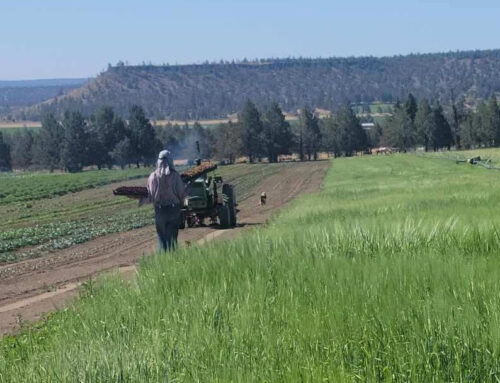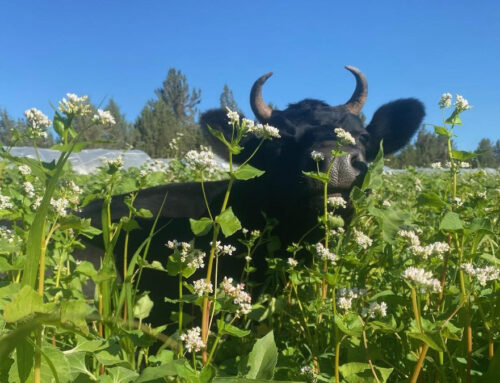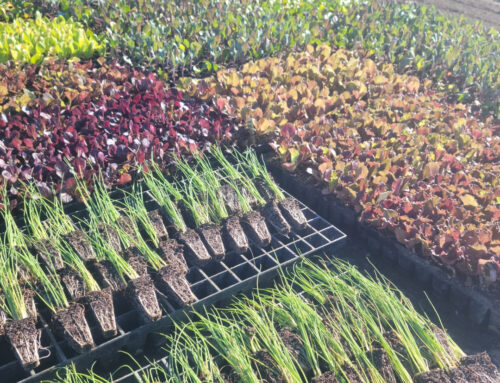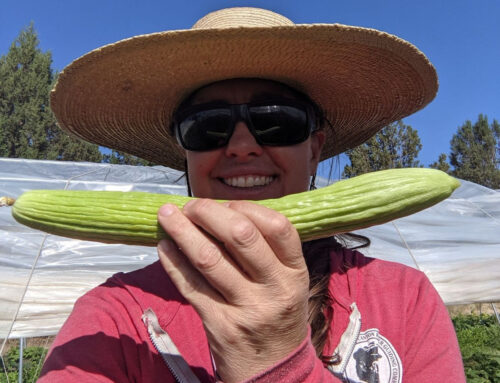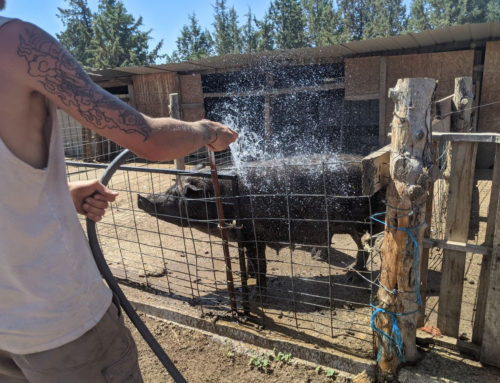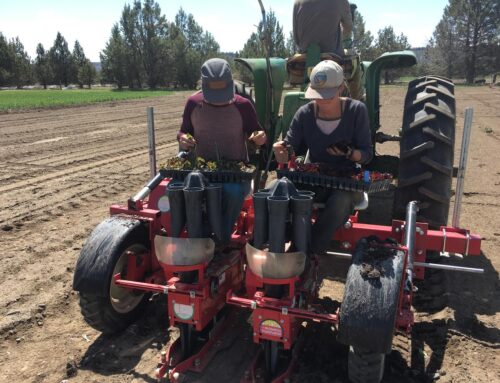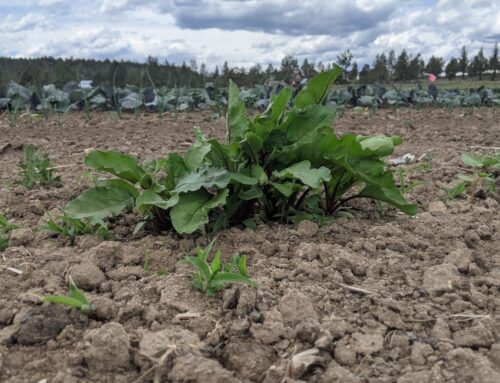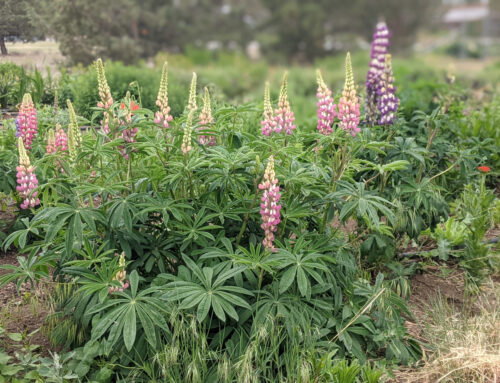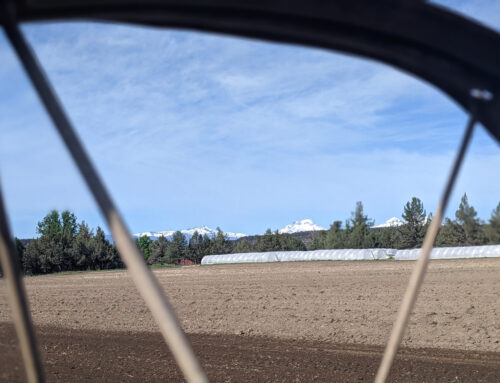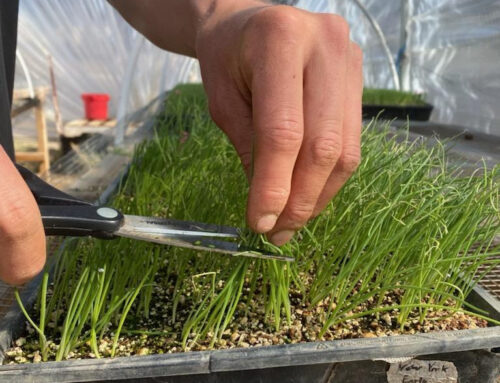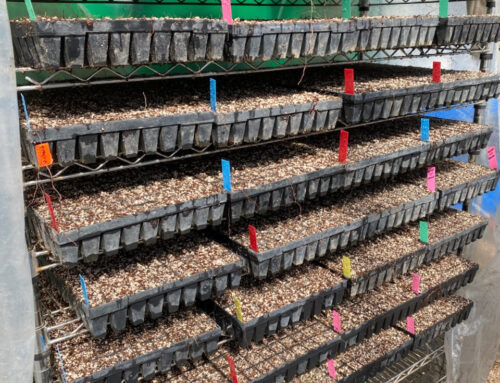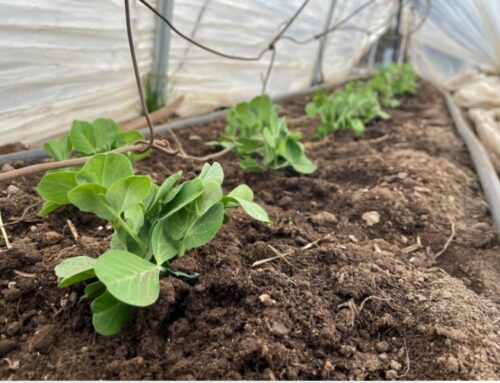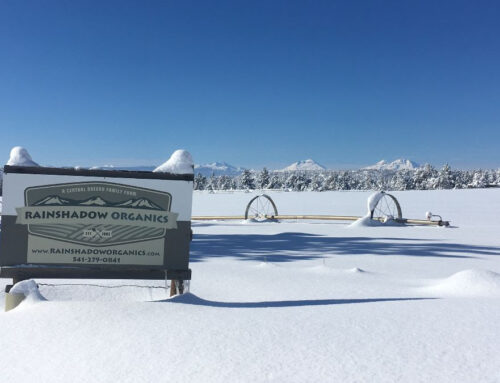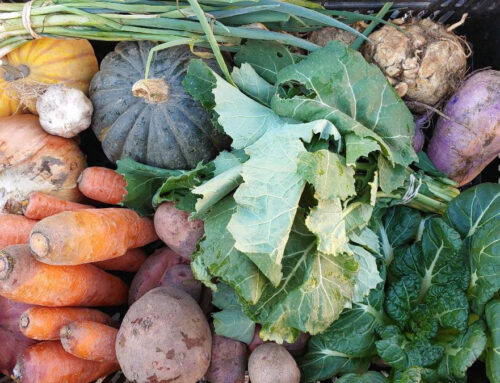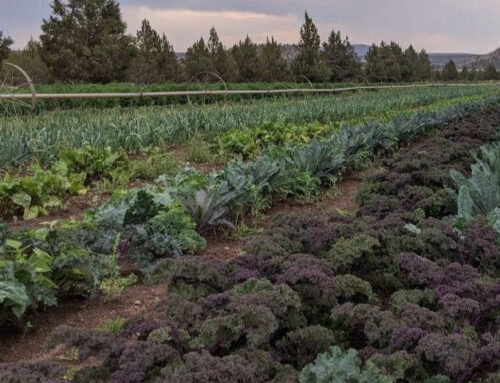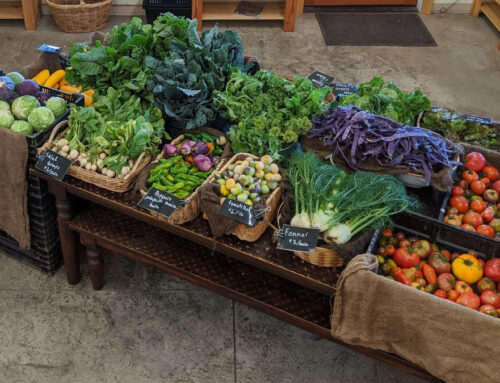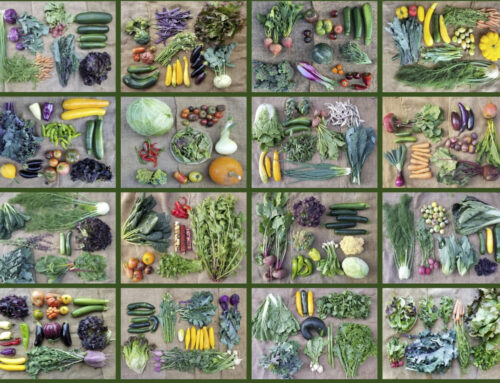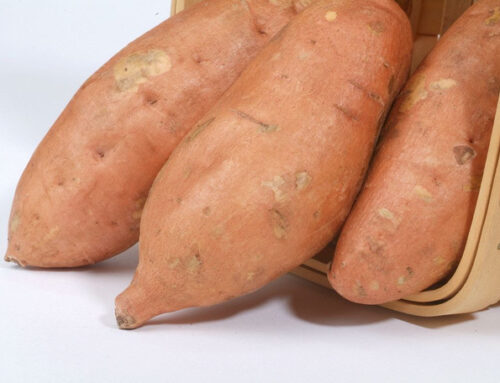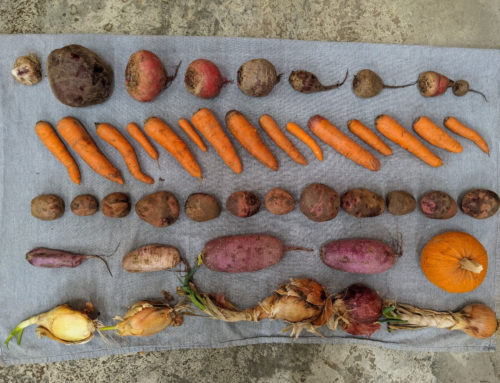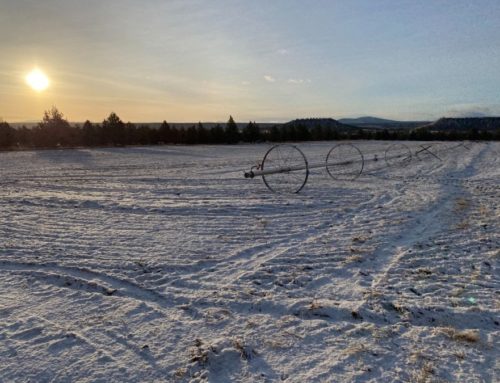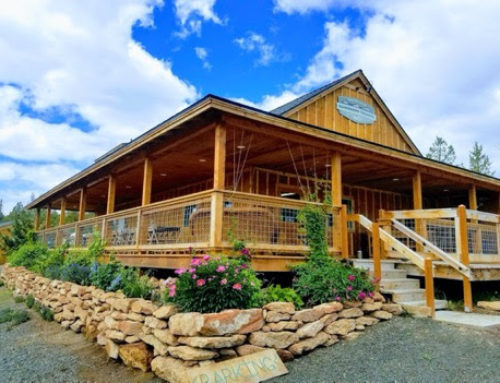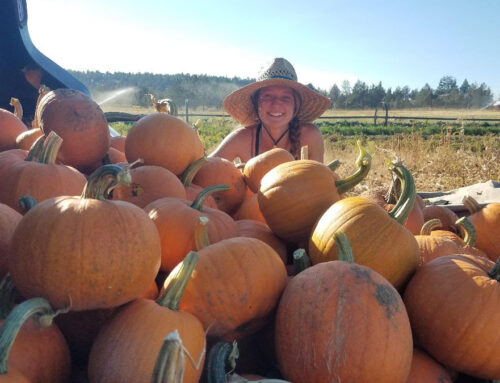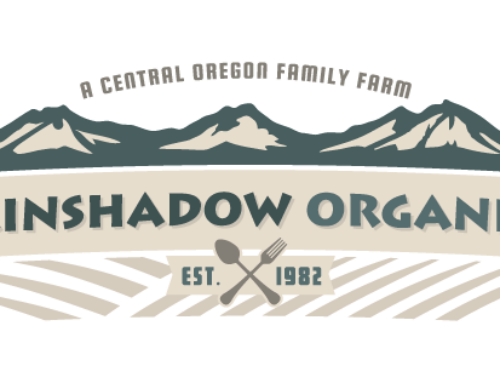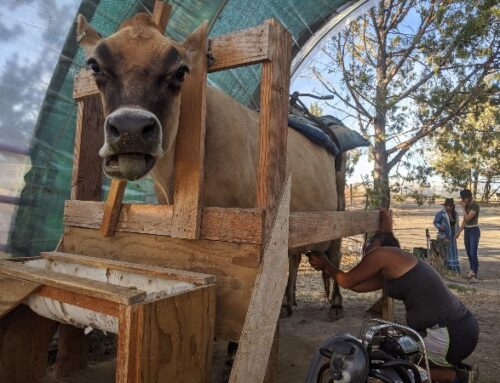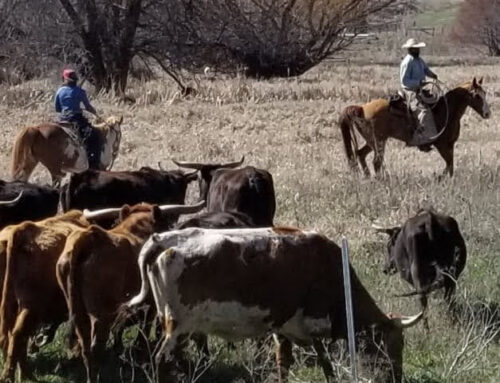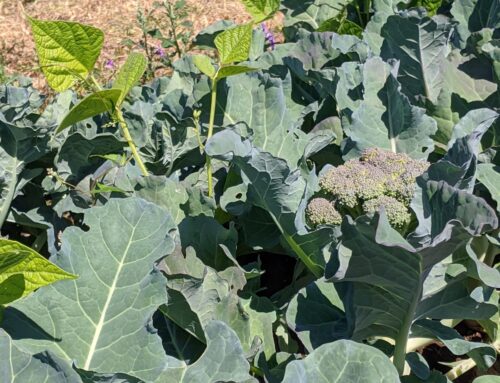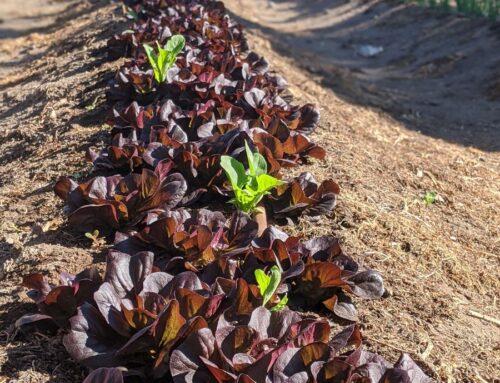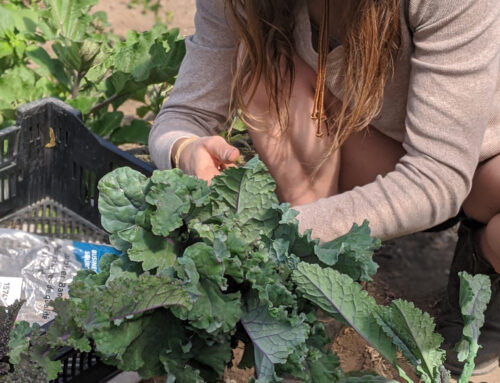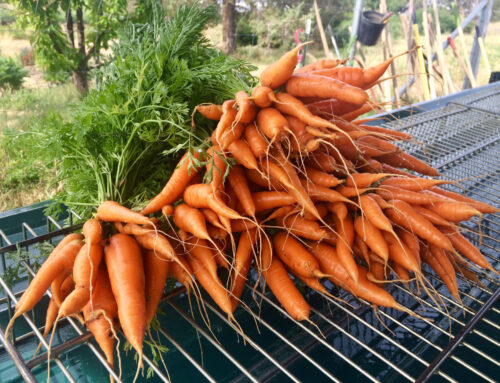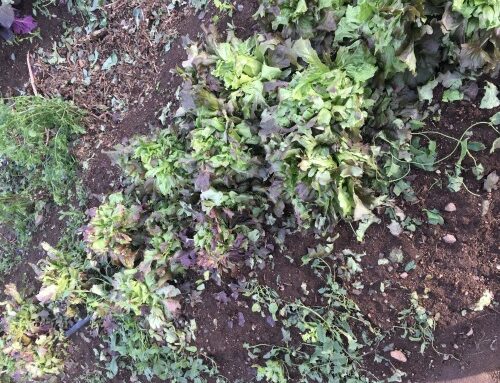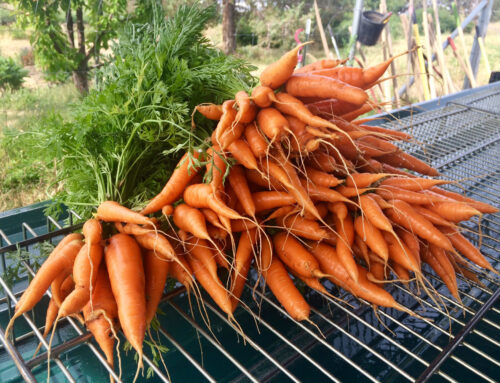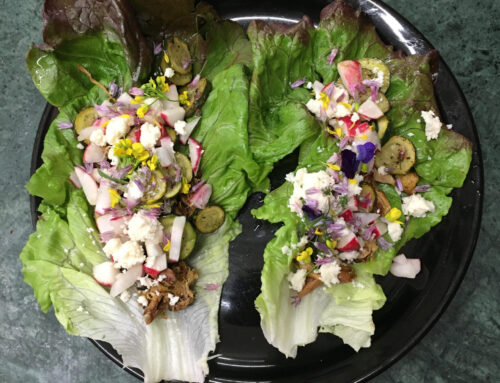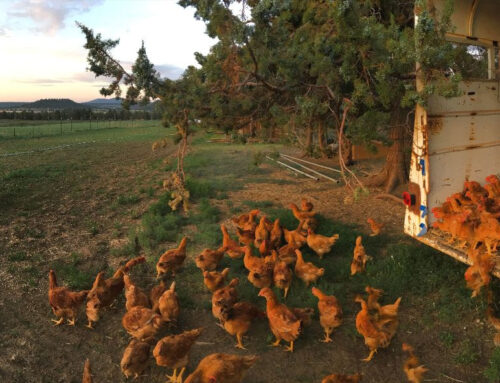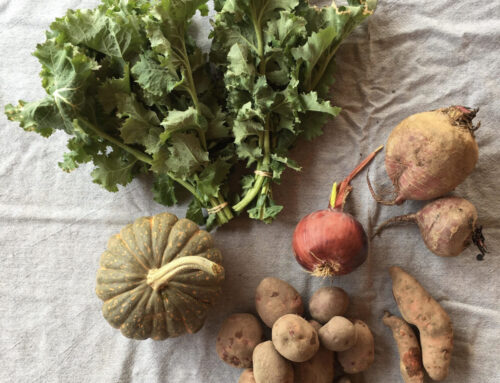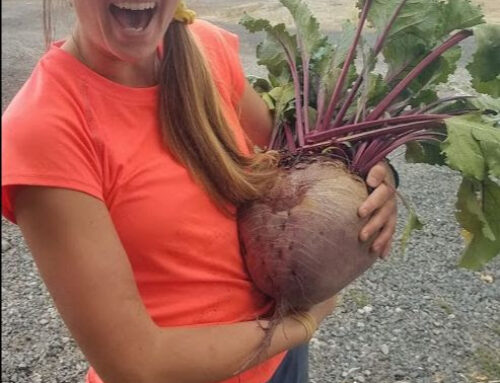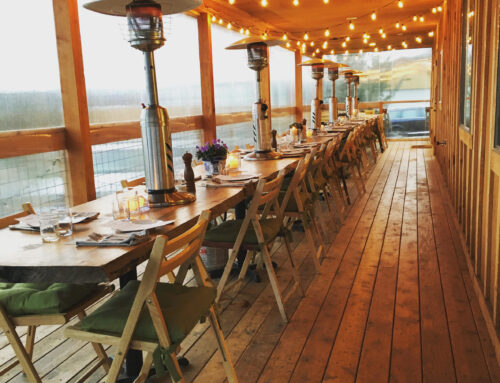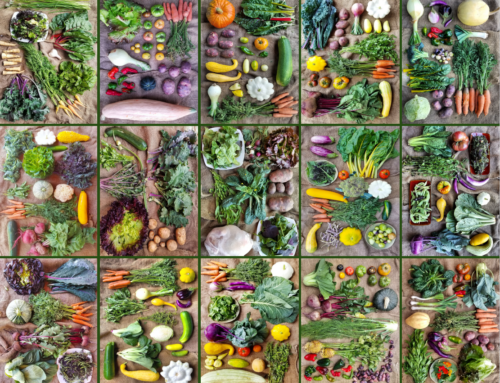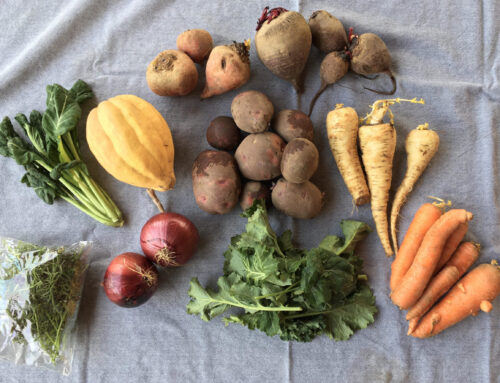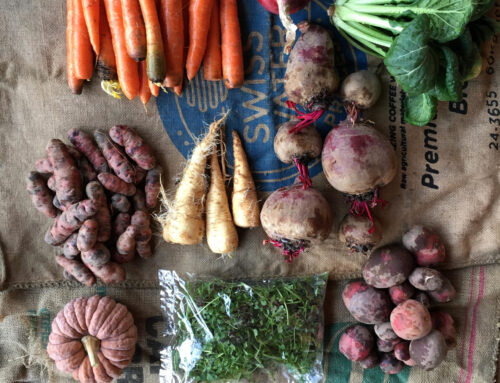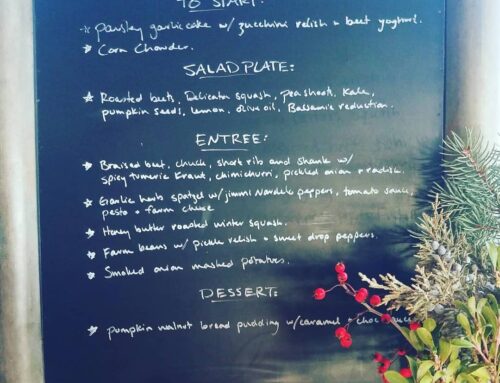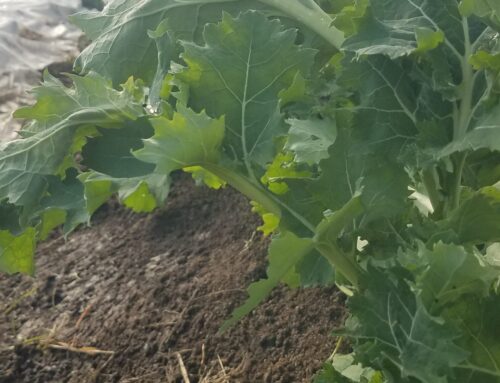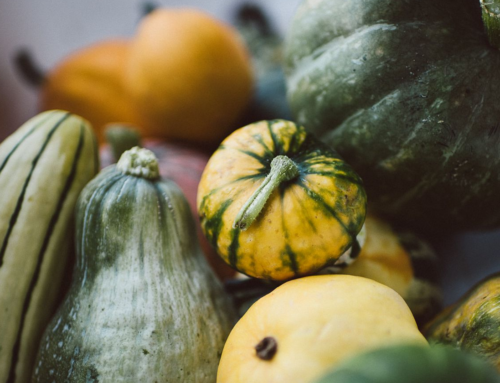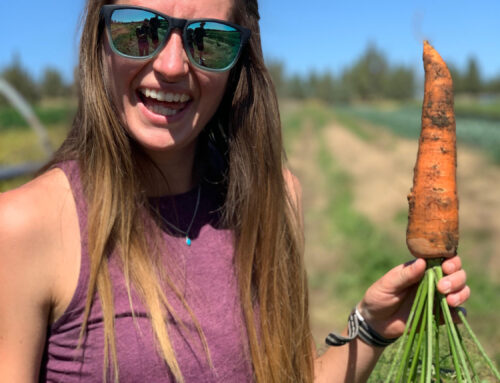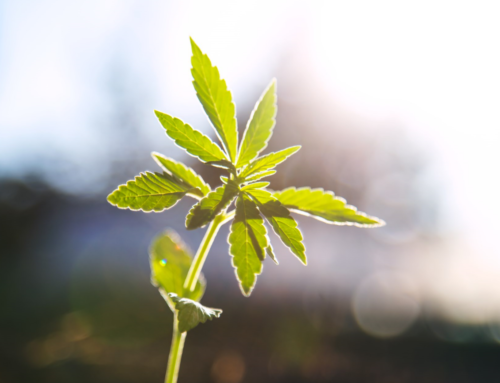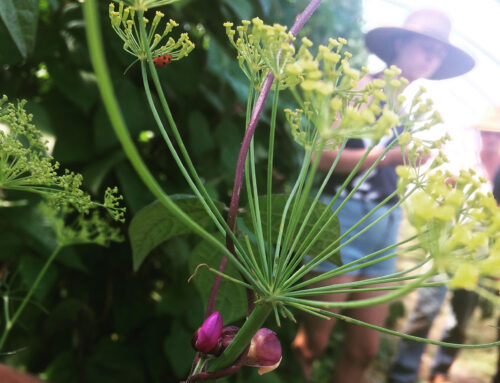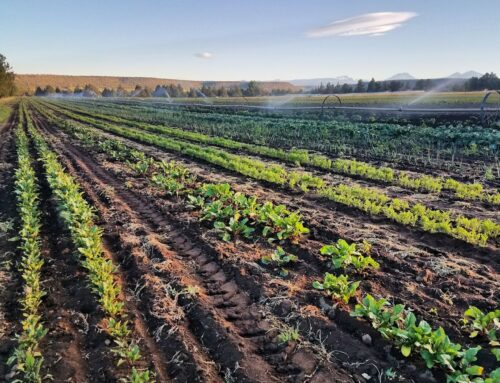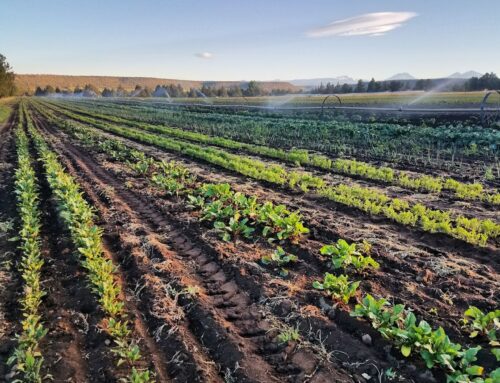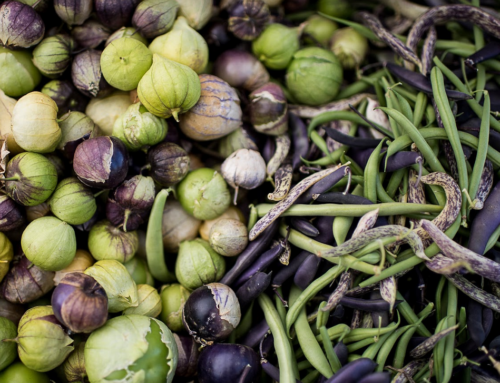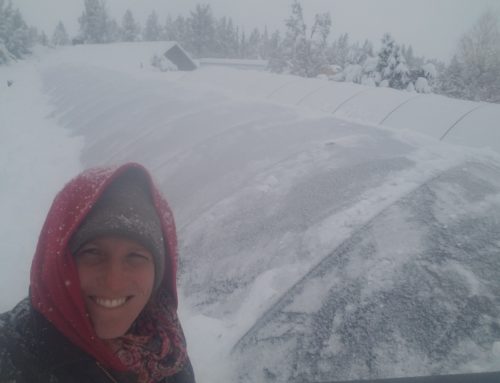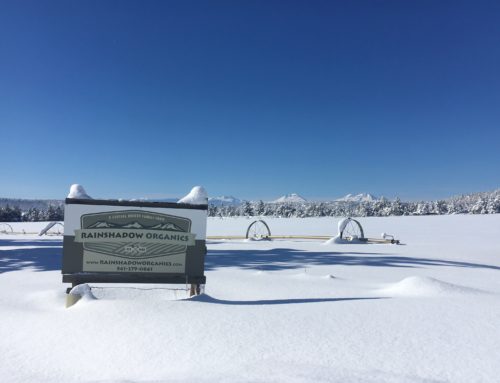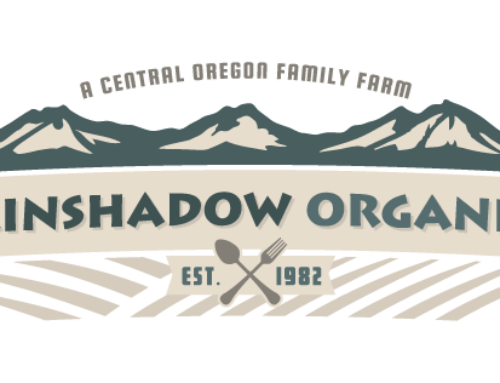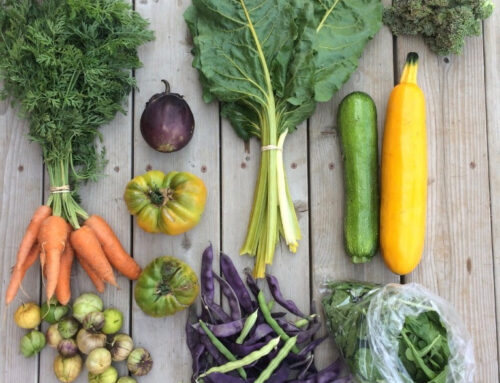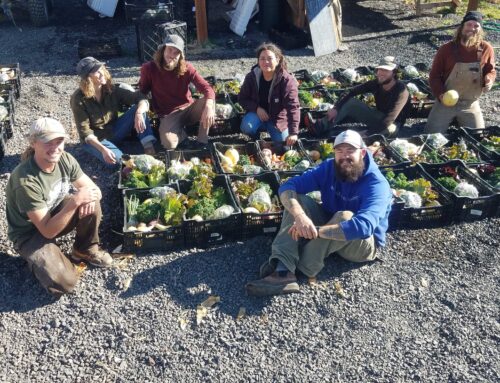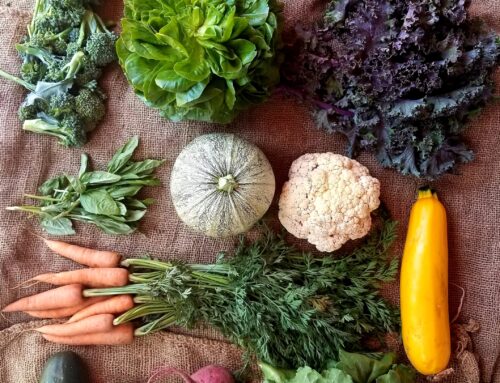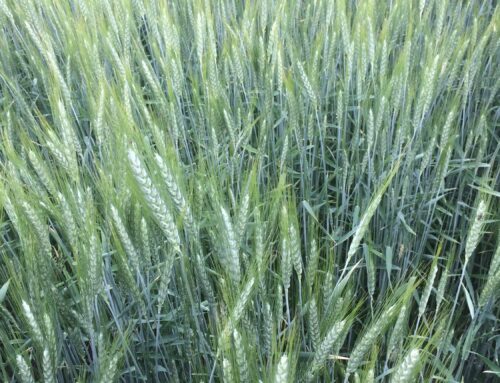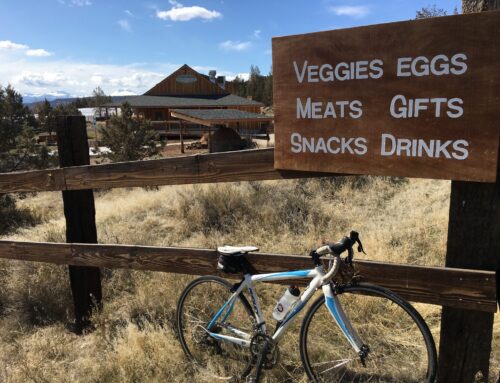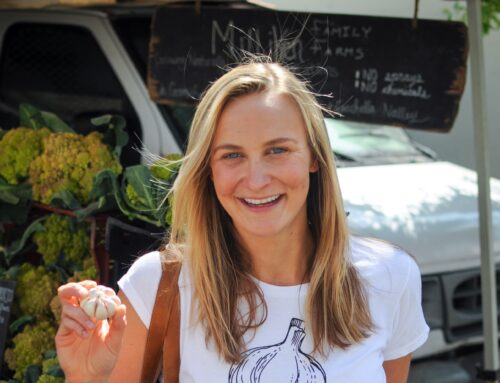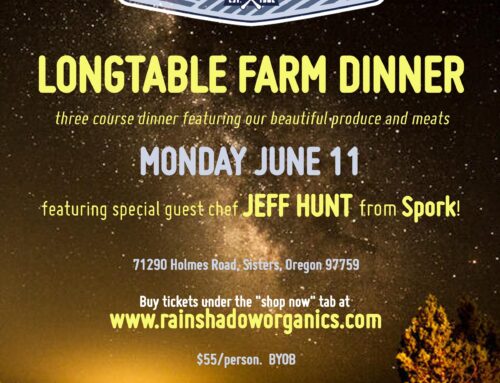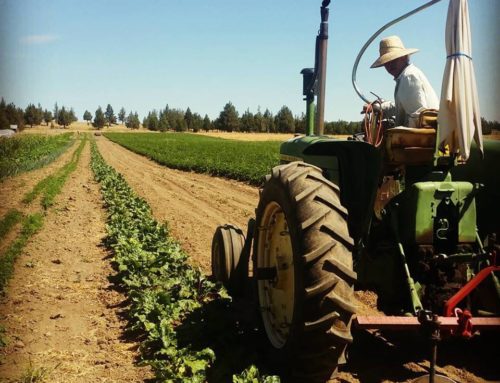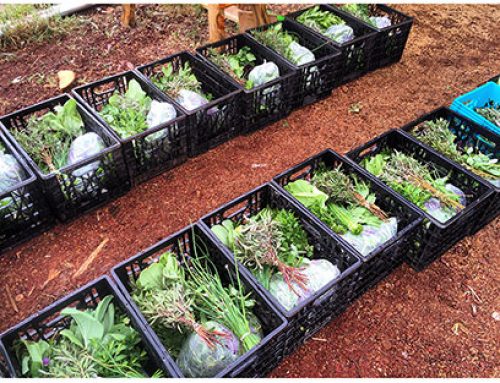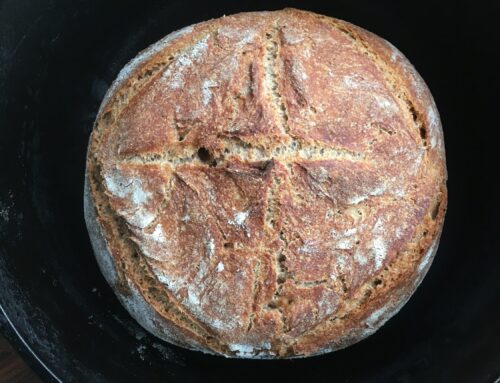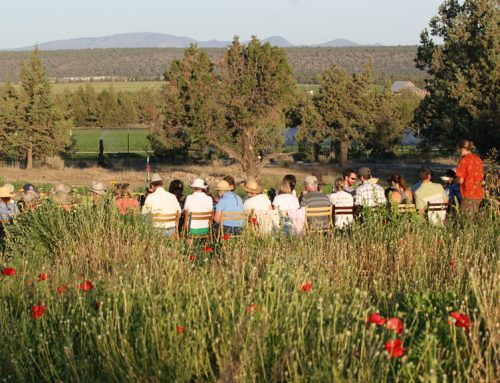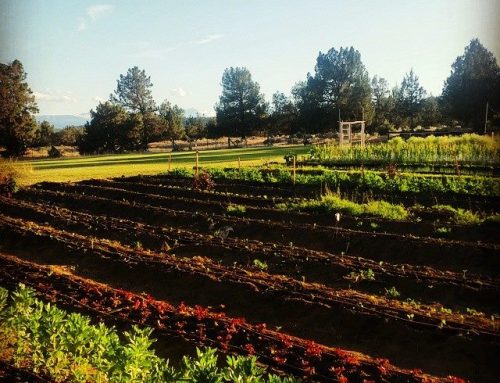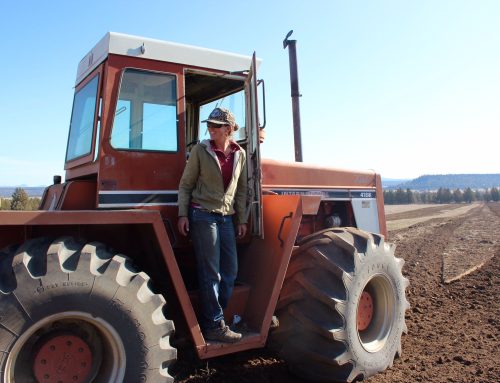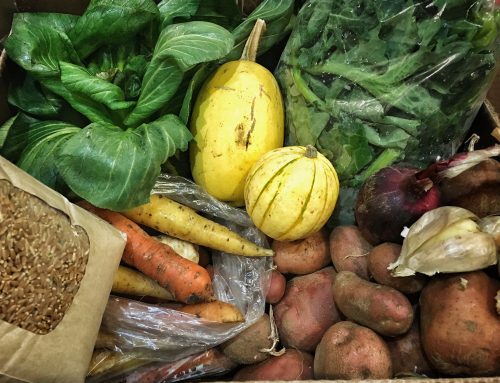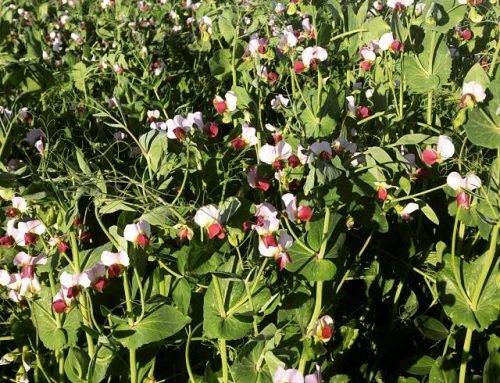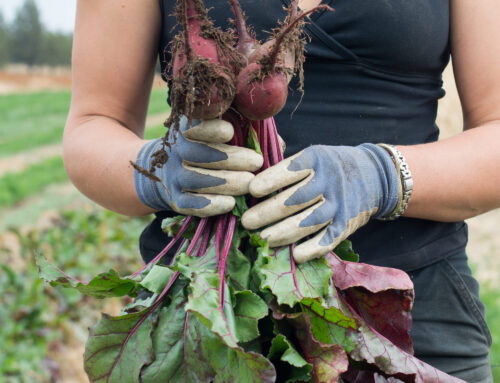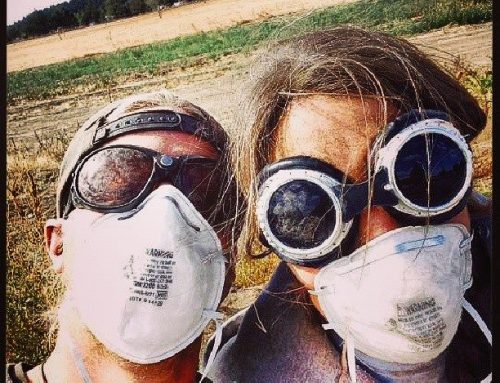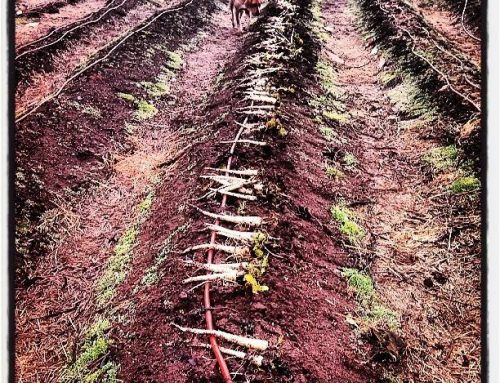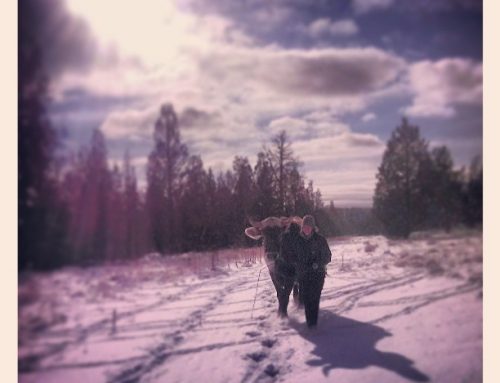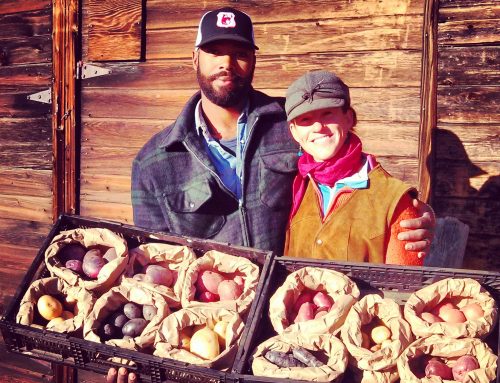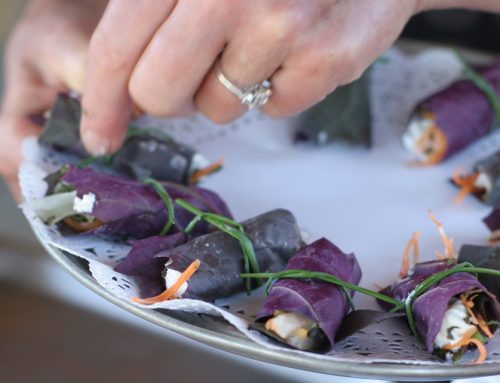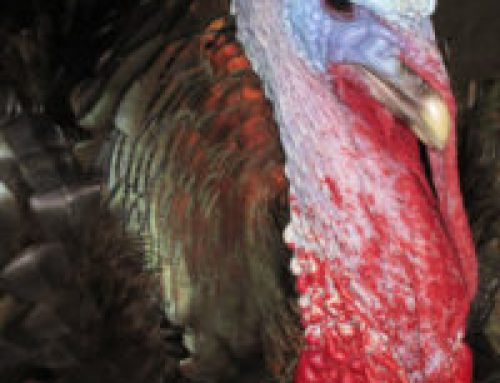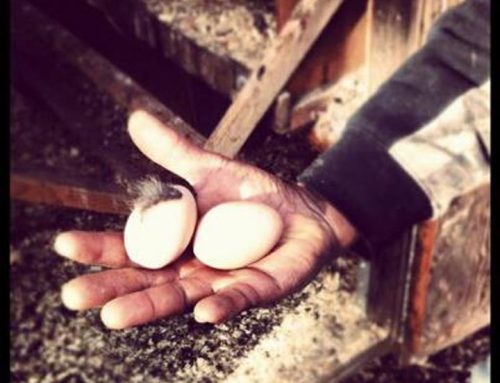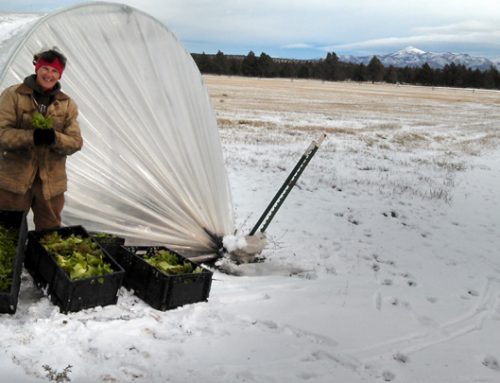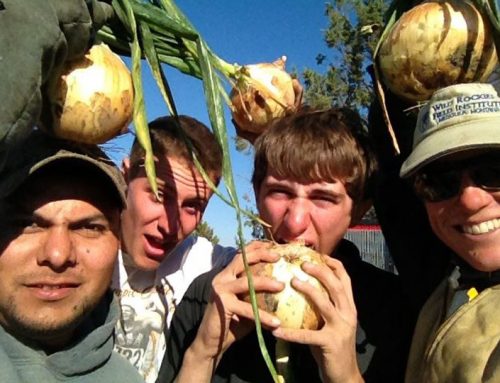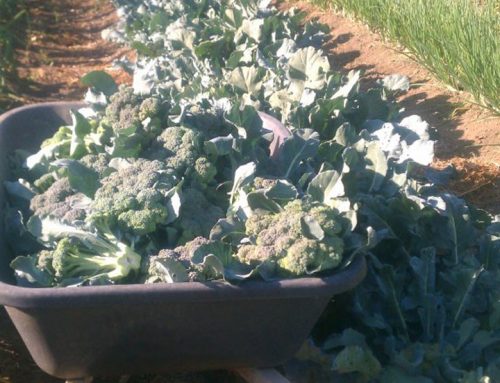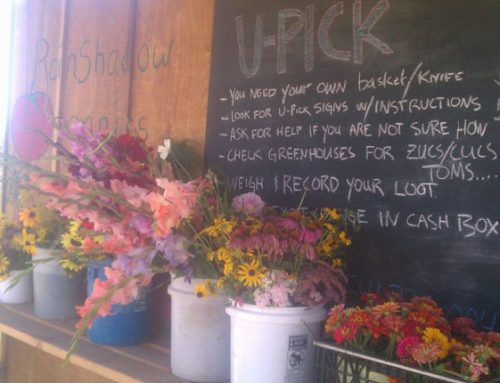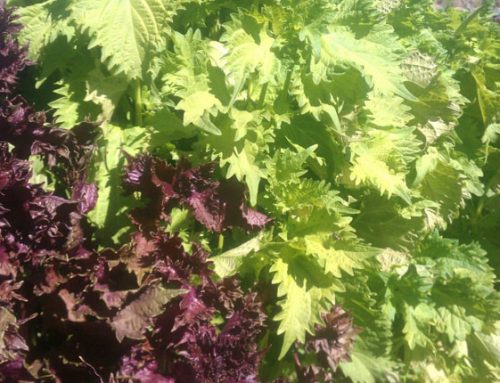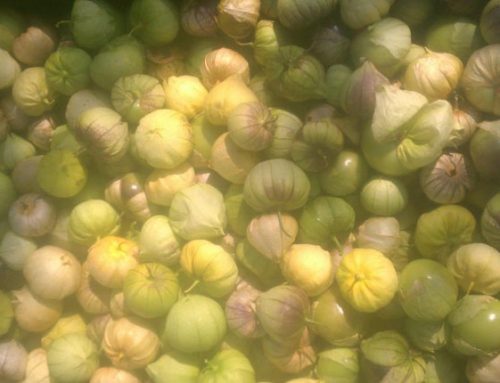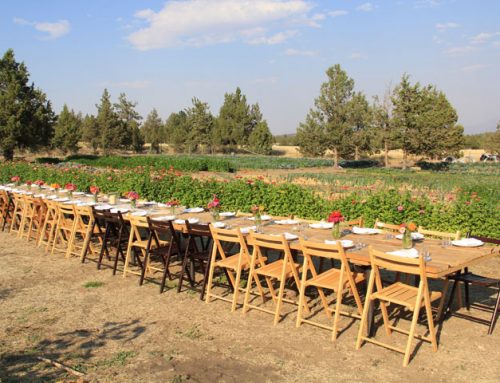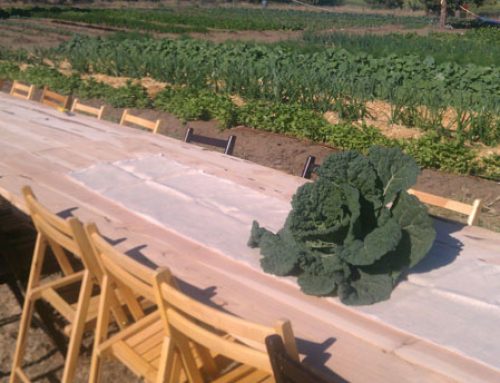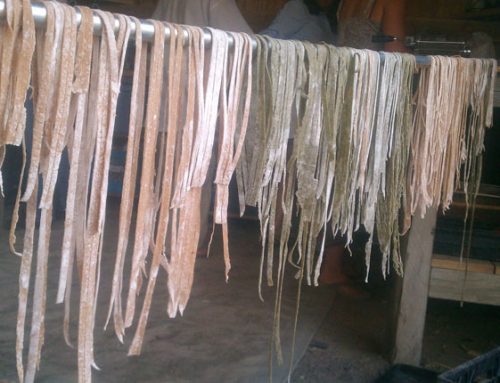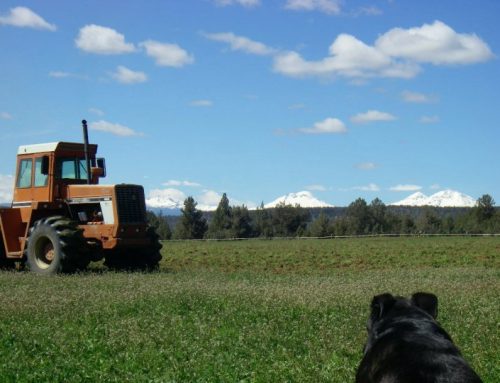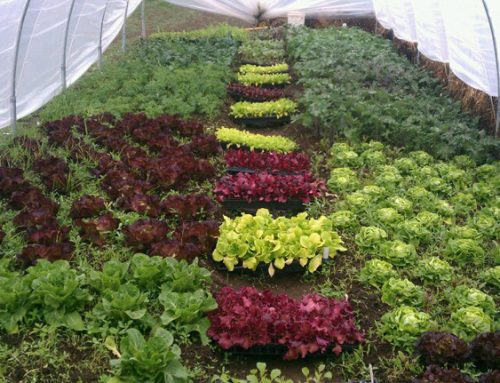But the veggies still think it is spring
The season has officially changed with the Solstice on Sunday, but it will still be a few more weeks until our vegetables catch up and those truly “summer” vegetables arrive. You can tell we are on the brink of the turn in vegetable season. There are baby peppers on the pepper plants and solid green tomatoes in the tomato houses. We have most of our summer successions either in the ground or started. We found a cucumber yesterday! We are getting giddy with the impending sense of abundance


Tomato and tomatillo plants blossoming are a sure indicator of their plentiful fruit in the future and the swiftly (though some might say not swift enough) approaching summer vegetable season!
(If you are curious about when you might be able to expect tomatoes and those deep summer vegetable options, don’t forget about the CSA Library on our website and the CSA Veggie Calendar you can find there.)
|
|

Flat: a flat consists of around 144 small squares that seeds are sewn into and plants are started in.
Start: we refer to a start or starts when we are talking about seeding plants in the 4-season greenhouse. This is often done 1-3 months before the baby plants are transplanted into the ground.
4-season greenhouse: we have on 4-season greenhouse at Rainshadow and all of our transplanted crops come out of it! This is a passive solar structure that has a wall of water tanks in the back to help it regulate its temperature. In the winter, the water tanks absorb the direct sunlight and warm up and in the summer, they help cool the place down. We assist its summer temperature regulation by opening and closing screen doors and turning fans on.


Halfway house: as plants outgrow the space in the 4-season and we need to get them ready to transplant into the field, we move them to a small hoop house where they can harden off in a protected environment.
Harden off: before plants can be transplanted, they need to get used to living outside in a more natural environment. As plants leave the protection of the 4-season greenhouse, they spend time in the halfway house getting used to the outside temperature and dry Central Oregon air.
Transplanting: the act of taking a start and either repotting it into a larger pot or planting it into its home for the growing season (a hoop house, a tomato house, or out in the field or the 2-acre garden).
The 2-Acre: the 2-acre garden is our original garden. We grow many of the same crops here that we do in the field, but we don’t use tractors or mechanization and we water with drip line instead of a wheel line.
Hoop House: we have 15 hoop houses at Rainshadow. These are unheated long tubes of protected growing space for our crops. Each hoop has 3 or 4 rows of vegetables growing in them. We open and close the sides of these houses depending on the temperature and the wind. Protection from the variable night time temps helps us grow greens all winter long and gives those summer, high heat plants a boost. We use our hoop houses to grow all sorts of things for the CSA: kale, peas, beans, tomatillos, peppers, summer squash, this list goes one. We definitely could never grow the diversity of vegetables we offer without our hoop houses.


Tomato Houses: these are the big brother of hoop houses. They are taller and boxier then the hoops and resemble more of a traditional greenhouse. We have 3 on the farm and they house our tomatoes as well as a rotating selection of vegetables: kohlrabi, cucumbers, lettuce, salad mix, green onions, sweet potatoes.
The Field: we refer to our 25-acre field on the corner of Holmes and Lower Bridge as the field. We use a tractor and mechanization to weed, seed, and transplant in the field. We rotate crops through the field in a cyclical manner to renew, rest, and rejuvenate the soil. At any given time you will find the field broken up into approximate thirds: 1/3 growing our heirloom, certified organic wheat, 1/3 growing our summer market crops and winter storage crops, and 1/3 covered in a cover crop (more to come on this in the June monthly email coming next week). We water the field with irrigation water delivered via a wheel line.
Biodynamic Calendar: we use a biodynamic calendar to help us seed, plant, and transplant our vegetables. The biodynamic calendar might feel a little woo-woo, but we have found it to help us out a lot in the success of our vegetables. The calendar breaks the days of the year up into auspicious and inauspicious days for planting fruiting, seeding, rooting, and leafing plants. We have done a few inadvertent tests and have proved to ourselves repeatedly that the biodynamic calendar has a strong place in how we decide when to do what at Rainshadow. Sometimes we can’t follow it (you just have to transplant all those kale on a certain day regardless of what the calendar says), but we notice the difference when we do.
(P.S. If you have specific language questions, or don’t understand a term, or wish to learn about something more then is touched on in an article, don’t hesitate to send us an email so we can elaborate more in a future email or chat with you directly. Farming, especially at Rainshadow is always a learning environment!)
Harvest List
We think our core vegetables this week are: Chard, Napa Cabbage, and 1 bunch of herbs. We will let you know on Wednesday how many other items you will get to select.
We have been keeping an eye on the hoops and 2-acre garden and have a pretty good idea of what is out there and ready to be harvested, but this is a Sunday estimation of what we will be harvesting on Tuesday. Also, because we have a market style CSA, this isn’t a guarantee of 1 of all these things for everyone. Instead, this will be the variety of what will hopefully (fingers crossed) have for you to choose from this week.)
| Herb options will hopefully include: Chives Dill Parsley Thyme Oregano Chives w/blossoms Other Vegetable Options will probably include: |
| Kale Asian Greens Hakurai Turnips Baby Fennel Zucchini Peas Salad Mix Arugula Spinach Carrots Green Onions |
Recipes
Here are a couple recipes to hopefully inspire you using herbs, chard, and Napa Cabbage.
We have been harvesting small fennel bulbs recently which would world well in the braised fennel recipe below. An added bonus to the braised fennel recipe is that it uses chard too.
Serves 4 to 6
2 to 6 heads (1 lb) fennel
1 onion
3 garlic cloves, left whole or roughly chopped
Zest of 1 lemon, stripped with a vegetable peeler
1 cup white wine or hard cider
Salt
1/2 teaspoon chili flakes (optional)
2 cups chicken stock or water
4 Tablespoons butter
4 garlic cloves, minced
1/2 cup olive oil, plus more for dressing
One 19-oz can white beans, drained and rinsed
2 bunches chard, cut into ribbons
1/2 cup pecans or other nuts
INSTRUCTIONS
To make the braised fennel:
- Heat oven to 350F.
- Trim the fennel, removing any bruised outer leaves and any wild stalks or fronts. Cut the bulbs in half or leave whole if they are small keeping the core intact. Wash well and allow to dry.
- In a large Dutch oven or frying pan over medium-high heat, sear or grill the fennel, cut-side down, until dark and caramelized. Add the onion, garlic, lemon zest, wine, 3 big pinches of salt, and chili flakes. Bring to a boil and reduce the wine by half. Add the stock and butter and bring to a boil.
- Remove from the heat, cover tightly with aluminum foil, and bake until the fennel is tender when pierced with a knife. Check after 30 minutes and cook until done.
- While fennel is braising, sweat the garlic in the oil with a large pinch of salt. Add the beans and stir to combine. Dress the chard with a glut of oil and pinch of salt. Serve the beans topped with the fennel and the chard salad. Sprinkle with the pecans.
This is one of my go to quick dinners when the cabbage is in. As a result, the measurements are less then exact!
INGREDIENTS
1 lb lean ground beef
2-3 Tablespoons minced/grated ginger
3 cloves garlic, minced
1 cup chopped onion
1 1/2 cup shredded carrots
Sliced green onions
¼ cup salted, dry-roasted peanuts
Hoisin Sauce
INSTRUCTIONS
- Add garlic, ginger, chopped onion, and a glut or two of cooking oil to a skillet. Add the ground beef and cook over medium heat until browned and crumbly; drain and return to skillet.
- Stir in carrots, soy sauce, and chili sauce and cook for 5 minutes. Taste and adjust seasonings as needed. Stir in basil and/or cilantro. Serve in cabbage leaves; sprinkle with nuts and top with Hoisin sauce.

Swiss chard has expansive, pocketed leaves with stems in a spectrum of colors: red, white, green, yellow. It is actually in the beet family but doesn’t develop a bulb. Its leaves are more tender and delicate than other greens. You can freeze chard for recipes later.

Napa or Chinese cabbage has tall leaves, and the heads are not as tightly bunched. This cabbage can be used in slaws, stirfrys, dumplings, soups, or as a wrap around ground beef (see recipe above). It sweetens while it cooks! Incidentally, this is the most commonly grown vegetable in China.
Add-Ons
Email us if you would like us to pack you anything extra from the store for pickup with your CSA. You can pay when you pick up at the Farm Store or our Farm Stand at the Bend Farmers Market.
Flours and Wheat Berries:
- 2 lb bags hard red, hard white, soft white flour: $5/bag
- 2 lb bag buckwheat flour: $7/bag
- 2 lb bag corn flour: $12/bag
- 2 lb bag rolled Tibetan black barley: $5/bag
- 3 lb bag hard white or hard red wheat berries $5/bag
Meat:
- $5/lb: beef liver
- $8/lb: ground beef
- $10/lb: chuck roast, brisket, and short ribs
- $11/lb: cubed round steak
- $14/lb: Rib Steak
Honey:
- Pint: $10/jar
- Quart: $20/jar
Were you stumped by a vegetable option in last week’s share?
Did you try a new recipe last week?
Did your greens last for less time than you feel they should?
Bring your questions, successes, and puzzles to our Members Only Facebook group and see how the hive mind can help!
I don’t know about you, but I sure am enjoying all these good spring greens. But, it’s true, I am getting more and more excited for the arrival of those summer fruiting vegetables!
Please email us let us know if you can’t make Wednesday or if someone else is picking up for you. We can’t wait to see you on Wednesday!




